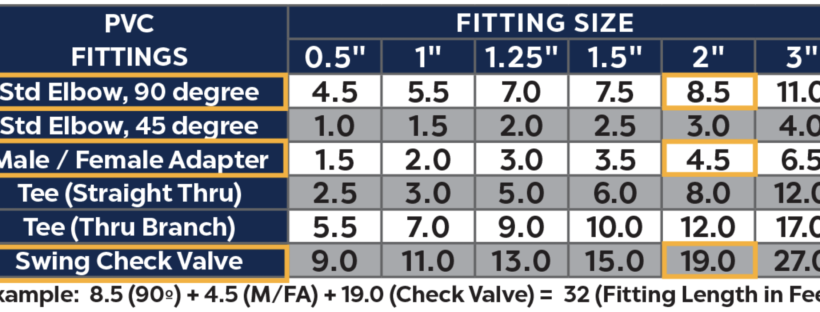Finding the right pump for a water feature can be a challenge, and the stakes are high. The right pump, delivering the right flow at the right head height, while at its Best Efficiency Range, will last and last. Specifying the wrong pump or plumbing can damage the pump, increase operating costs, shorten pump life and lead to pump failure, perhaps even a fish kill if the water feature happens to be a fish pond.
In order to properly size the pump for any water feature, you’ll need to know both components of the work it has to do, the flow and the pressure. The flow is the volume of water it can push in a given time, measured in gallons per hour (GPH). The pressure is the force required to push that flow through plumbing and up to the top of the water feature. We measure pressure in ‘feet of Head”, because it’s easy to visualize. A waterfall four feet high requires the flow be delivered at 4 feet of “Vertical Head”, plus the extra work required to push that flow through the plumbing, the “Friction Head”. The total pressure required is the “Total Dynamic Head” (TDH) of your water feature. Once you know the GPH and the TDH, you can plug them into the Comprehensive Pump Chart (Chart C) to find the right pump.
Follow the steps below to calculate TDH and find the perfect pump for your water feature.
Find the GPH needed to achieve the look you want
determine friction loss
FIND TUBING SIZE & FRICTION
Find the dark blue cell in the row that corresponds with the Recommended Flow (GPH) in the chart below. The column indicates the recommended tubing size and the number in the cell is the Friction Loss in every foot of tubing. Keep Friction Loss low for greatest flow.
To find the Friction Loss of existing systems, estimate the flow through the actual tubing size used.
Chart A

ADD FRICTION IN FITTINGS
Add the equivalent lengths of all the fittings in the system from the chart below.

CALCULATE FRICTION HEAD
Multiply the Equivalent Tubing Length in feet by the Friction Loss in the dark blue cell from CHART A to find the Friction Head of the system.
FIND THE TOTAL DYNAMIC HEAD
Add the Friction Head in Feet to the Vertical Head of the system. Vertical Head is the height in feet from the surface of the water the pump will be TDH sitting in, to the highest point the water is pumped to.
CHOOSE YOUR TIDALWAVE PUMP
Find the TDH at the top of CHART C, then find the pumps below that provide at least the Recommended Flow. Grey colored cells indicate that the TDH is outside the pump’s operating range and the pump will likely not last in this application. The light blue cells indicate the pump is operating within its operating range. Dark blue means the TDH is in the pump’s Best Efficiency Range, where the pump will run best and longest. If the chart gives you a choice of more than one pump, check for the type that best fits your application from the list below, then check for the lowest wattage, to save on operating costs.
- For Low Head, Low Volume applications, use Magnetic Drive Pumps (MD Series)
- For Low Head, Very High Volume applications, use Axial Pumps (L-Series) with 3″ or larger tubing
- For Medium Head, Medium Volume, use Asynchronous Pumps (TT-Series)
- For High Head, High Volume Applications, use Direct Drive Pumps (A-Series)
- For Solids and Dirty Water applications, use Direct Drive Solids Handling Pumps (PAF and SH-Series)
Chart C
To learn more on how to Calculate Total Dynamic Head, watch the How-To video on our YouTube channel, AWGtv.





I have been looking at calculators for pumps for a week, and this was hands down the best. Thanks!